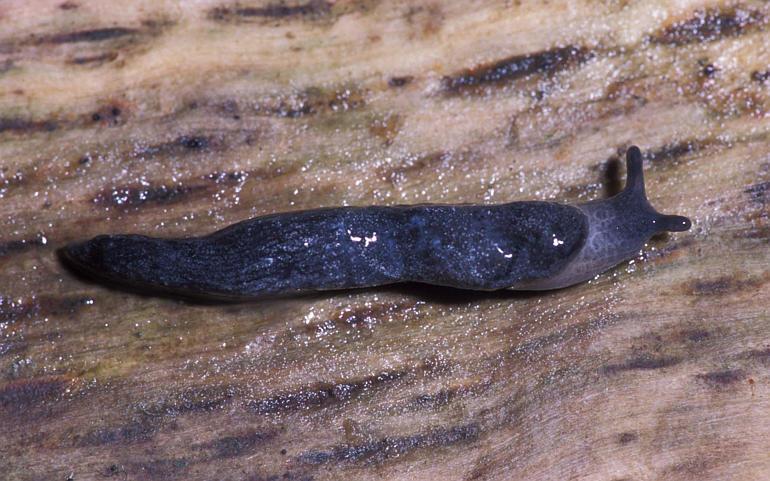Low-
Moderate
The blue-gray taildropper is rare and perhaps declining in Washington, and its known populations are scattered and somewhat disjunct. Nothing is known about population size and trends. This endemic slug is of concern due to their rarity, which suggests they have specific habitat needs that make them sensitive to land use activities, such as logging and loss of coarse woody debris.
Description and Range
Physical description
The blue-gray taildropper slug is a small to medium-sized slug, ranging in size from about 3/4 to 1 1/4 inches (20 to 40 millimeters) in length when fully extended. As its common name suggests, it ranges in color from gray to blue, often with some fine, light speckling.
Ecology and life history
The blue-gray taildropper inhabits moist, coniferous or mixed-wood forests of varying age classes and is associated with moist forest floor conditions and abundant coarse woody debris, particularly of bigleaf maple. All records from British Columbia are from within the Coastal Douglas-fir biogeoclimatic zone (a type of broad, climatic ecosystem as classified by the British Columbia Ministry of Forests), while in Washington, it is often associated with older forests and required microhabitat features, including abundant coarse woody debris or other cover, a deep forest litter layer and shaded, moist forest floor conditions.
Like most terrestrial gastropods, taildroppers are hermaphroditic, having both male and female organs. Although not confirmed specifically for the blue-gray taildropper, self-fertilization has been demonstrated in some species of gastropods, but cross-fertilization is the norm.
Slugs are generally oviparous (egg-laying). Eggs of Prophysaon slugs are laid in clusters in cool damp spots including under logs or pieces of wood on the shaded forest floor. This species appears to have an annual life cycle, maturing and reproducing within one year.
Slugs are preyed upon by a variety of vertebrates and other invertebrates. If threatened, the slug can drop its tail as a means to escape some predators.
Fungi makes up most (90 percent) of the identifiable food ingested by the blue-gray taildropper; this includes a variety of mycorrhizal fungi and the species may be an agent of spore dispersal for these fungi, which are beneficial symbionts of many plants. Other food items include plant material and lichens; plant material is more commonly consumed in spring than in fall.
Geographic range
The blue-gray taildropper occurs in a few isolated populations and is a rare Pacific Northwest endemic closely associated with coniferous forest stands and conifer debris. In Washington, scattered sites are documented within the Puget Trough; extant populations occur in Lewis and Cowlitz Counties.
The entire species range encompasses the Oregon Coast Range, Oregon and Washington Cascades, Puget Trough, Klamath Mountains of southwestern Oregon and northern California, western Idaho, and southern Vancouver Island, British Columbia.
Although somewhat widespread and abundant in southwestern Oregon, it is rare and likely declining elsewhere in its range (including the rest of Oregon, and in California, Washington, Idaho, and British Columbia) with populations scattered and disjunct.
Climate vulnerability
Sensitivity to climate change
Low-
Moderate
There is limited information regarding the sensitivity of Bluegray taildroppers to climate change. Their main sensitivity is likely to be driven by changes in their preferred habitat – older, late successional, forests with moist ground and a mixture of hardwood and conifer trees. Increases in temperature and decreases in summer rainfall are likely to lead to increased risk of severe fires, which would destroy habitat for this species. Declines in habitat quality could also lead to fragmentation of populations, particularly since slugs are not very mobile, and eventual population declines. Additionally, decreased summer rainfall and increased droughts could lead to changes in soil moisture and availability of fungal populations that this species feeds on.
Exposure to climate change
Moderate
- Increased temperatures
- Reduced soil moisture and/or changes in precipitation
- Altered fire regimes
Conservation
Conservation Threats and Actions Needed
- Agricultural side effects
- Threat: Logging of and alteration mature sites; loss of coarse woody debris; harvest of understory vegetation.
- Actions Needed: Identify, protect, and monitor sites. Gather more information on habitat composition and requirements. Clarify taxonomy to determine true range and habitat.
See the Climate vulnerability section for information about the threats posed by climate change to this species.
Resources
References
Burke, T. E. 2013. Land Snails and Slugs of the Pacific Northwest. Oregon State University Press, Corvallis, OR. 344pp.
COSEWIC. 2006. COSEWIC assessment and update status report on the blue-grey taildropper slug Prophysaon coeruleum in Canada. Committee on the Status of Endangered Wildlife in Canada. Ottawa, Canada. 27 pp.
Jordan, S.F. and S.H. Black. 2014. Conservation Assessment for Prophysaon coeruleum, blue-gray taildropper. Interagency Special Status and Sensitive Species Program. USDA Forest Service Region 6 and USDI Bureau of Land Management, Oregon and Washington. 29 pp.
McGraw, R., N. Duncan and E. Cazares, 2002. Fungi and other items consumed by the Blue-gray Taildropper slug (Prophysaon coeruleum) and the Papillose Taildropper slug (Prophysaon dubium). The Veliger, Vol. 45, No. 3, Pp. 261-264.
Wilke, T. and N. Duncan 2004. Phylogeographical patterns in the American Pacific Northwest: lessons from the arionid slug Prophysaon coeruleum, Molecular Ecology (2004) 13: 2303-2315.
